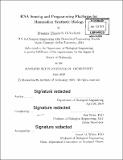| dc.contributor.advisor | Ron Weiss. | en_US |
| dc.contributor.author | DiAndreth, Breanna Elizabeth. | en_US |
| dc.contributor.other | Massachusetts Institute of Technology. Department of Biological Engineering. | en_US |
| dc.date.accessioned | 2019-11-22T00:08:53Z | |
| dc.date.available | 2019-11-22T00:08:53Z | |
| dc.date.copyright | 2019 | en_US |
| dc.date.issued | 2019 | en_US |
| dc.identifier.uri | https://hdl.handle.net/1721.1/123058 | |
| dc.description | Thesis: Ph. D., Massachusetts Institute of Technology, Department of Biological Engineering, 2019 | en_US |
| dc.description | Cataloged from PDF version of thesis. | en_US |
| dc.description | Includes bibliographical references (pages 153-173). | en_US |
| dc.description.abstract | The field of synthetic biology aims to control cellular behavior using programmable gene circuits. Generally these gene circuits sense molecular biomarkers, process these inputs and execute a desired calculated response. This is especially relevant for gene and cell therapies where integrating multiple disease-related inputs and/or sophisticated control could lead to safer and more effective approaches. While mammalian synthetic biology has made great progress, few gene circuit-based therapies have entered the clinic. Regulatory issues aside, this lag may be due to several technical impediments. First, the computing part of circuits is often accomplished via transcriptional regulation, which presents challenges as we move toward the clinic. Second, the field relies on a limited set of sensors; the detection of other types of disease biomarkers will help robustly identify cell state. | en_US |
| dc.description.abstract | Finally, the design cycle currently used to develop gene circuits is laborious and slow, which is not suitable for clinical development, especially applications in personalized medicine. In this thesis I describe how I address these three limitations. I develop a new posttranscriptional regulation platform based on RNA cleavage that I term "PERSIST" (Programmable Endonucleolytic RNA Scission-Induced Stability Tuning). CRISPR-specific endonucleases are adapted as RNA-level regulators for the platform and we demonstrate several genetic devices including cascades, feedback, logic functions and a bistable switch. I explore sensor designs for relevant biomolecules including mRNAs, miRNAs and proteins via the PERSIST and other platforms. Finally, I present a "poly-transfection" method, associated advanced data analysis pipelines, and computational models that make circuit engineering faster and more predictive. | en_US |
| dc.description.abstract | Taken together, the expanded RNA toolkit that the PERSIST platform offers as well as advancements in sensing and circuit design will enable the more straightforward creation of robust gene circuits for gene and cell therapies. | en_US |
| dc.description.statementofresponsibility | by Breanna Elizabeth DiAndreth. | en_US |
| dc.format.extent | 173 pages | en_US |
| dc.language.iso | eng | en_US |
| dc.publisher | Massachusetts Institute of Technology | en_US |
| dc.rights | MIT theses are protected by copyright. They may be viewed, downloaded, or printed from this source but further reproduction or distribution in any format is prohibited without written permission. | en_US |
| dc.rights.uri | http://dspace.mit.edu/handle/1721.1/7582 | en_US |
| dc.subject | Biological Engineering. | en_US |
| dc.title | RNA sensing and programming platforms for mammalian synthetic Biology | en_US |
| dc.title.alternative | Ribonucleic acid sensing and programming platforms for mammalian synthetic Biology | en_US |
| dc.type | Thesis | en_US |
| dc.description.degree | Ph. D. | en_US |
| dc.contributor.department | Massachusetts Institute of Technology. Department of Biological Engineering | en_US |
| dc.identifier.oclc | 1127290481 | en_US |
| dc.description.collection | Ph.D. Massachusetts Institute of Technology, Department of Biological Engineering | en_US |
| dspace.imported | 2019-11-22T00:08:52Z | en_US |
| mit.thesis.degree | Doctoral | en_US |
| mit.thesis.department | BioEng | en_US |
